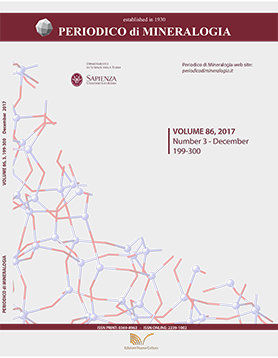A New kimberlite pipe in Balkamthota Vanka, Pennahobilam, Anantapur district, Andhra Pradesh, India. Field aspects and preliminary investigations
DOI:
https://doi.org/10.2451/2017PM689Keywords:
New Kimberlite pipe, Group- I and II, Petrography, Geochemistry, Petrogenesis, Diamond Prospectivity, Pennahobilam.Abstract
Systematic closely spaced geological traverses conducted in the year 2010, in Lattavaram Kimberlite Cluster (LKC) of Anantapur district, Andhra Pradesh, India, have led to the discovery of a new kimberlite pipe outcrop in the river bed of Balkamthota Vanka (name of the stream used by local farmers) at its confluence with Penna River, close to Pennahobilam. This new pipe occurs at a distance of 1.5 km in NE direction to hitherto reported pipes-5 and 13 occurring at Muligiripalli and Tummatapalli respectively in the LKC of the Wajrakarur Kimberlite Field (WKF). With this pipe, the total number of kimberlite pipes in the WKF raises to 48, considering all the kimberlites discovered by various public and private organizations so far. Preliminary petrography, geochemistry, petrogenetic aspects and diamond prospectivity of the new occurrence have been presented here. Mineralogically, the kimberlite constitutes olivine macrocrysts, serpentinsed olivine psuedomorphs with xenocrystic ilmenite, phlogopite, perovskite, magnetite, Cr-diopside, garnet along with calcite veins. The kimberlite is classified as hypabyssal macrocrystic calcite- phlogopite kimberlite. Mineralogically, the new kimberlite pipe appears as archetypal Group- I kimberlite however, geochemically; the kimberlite shows character of both Group- I and II varieties, more close to lamproitic character. Although it is too early to comment, based on limited analyses carried out in this study, the diamond potentiality of this pipe is not encouraging; it is noteworthy that it highly warrants detailed investigations involving bulk rock geochemistry and drilling to assess its definite geochemical status, petrogenesis and diamond potentiality.


